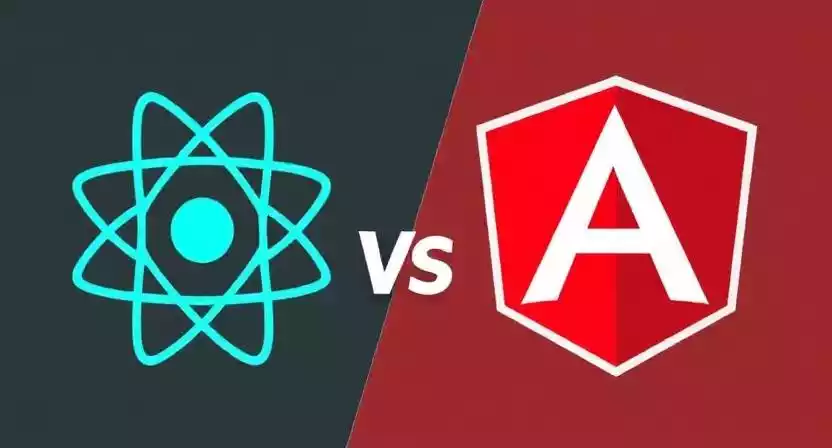In the fast-paced world of web development, choosing the right frontend framework is critical. React and Angular are two of the most dominant players, widely adopted by startups, enterprises, and global tech giants alike. While both serve the same purpose—building dynamic user interfaces—they differ significantly in their architecture, philosophy, learning curve, and ecosystem.
In this blog, we’ll explore React vs Angular in depth, backed by code examples, pros and cons, and real-world use cases.
? What is React?
React is a JavaScript library developed by Facebook for building user interfaces, especially for single-page applications. It emphasizes a component-based architecture and uses a virtual DOM to optimize rendering performance.
- Initial Release: 2013
- Maintained by: Meta (Facebook)
- Language: JavaScript / JSX
- Type: Library
Sample React Code:
jsxCopyEditimport React, { useState } from 'react';
function Counter() {
const [count, setCount] = useState(0);
return (
<div>
<h1>React Counter</h1>
<p>Count: {count}</p>
<button onClick={() => setCount(count + 1)}>Increment</button>
</div>
);
}
export default Counter;
? What is Angular?
Angular is a full-fledged front-end framework developed and maintained by Google. It follows a Model-View-Controller (MVC) architecture and uses TypeScript, a statically typed superset of JavaScript. Angular provides everything out of the box—from routing and forms to HTTP services.
- Initial Release: 2016 (Angular 2+)
- Maintained by: Google
- Language: TypeScript
- Type: Framework
Sample Angular Code:
typescriptCopyEditimport { Component } from '@angular/core';
@Component({
selector: 'app-counter',
template: `
<h1>Angular Counter</h1>
<p>Count: {{ count }}</p>
<button (click)="increment()">Increment</button>
`
})
export class CounterComponent {
count = 0;
increment() {
this.count++;
}
}
? React vs Angular: Head-to-Head Comparison
| Feature / Aspect | React | Angular |
|---|---|---|
| Type | Library | Full-fledged Framework |
| Language | JavaScript / JSX | TypeScript |
| DOM | Virtual DOM | Real DOM with change detection |
| Learning Curve | Moderate | Steep |
| State Management | External libraries (Redux, Zustand, etc.) | Built-in services & RxJS |
| Routing | React Router (external) | Angular Router (built-in) |
| UI Components | External (Material-UI, AntD) | Built-in (Angular Material) |
| Performance | Faster for lightweight apps | Better for large-scale apps |
| Community Support | Larger with more third-party tools | Strong enterprise backing |
| Dependency Injection | Manual or via Context API | Built-in and robust |
✅ Pros and Cons
React
Pros:
- Component-based, reusable architecture
- Faster rendering with Virtual DOM
- Huge community and ecosystem
- Easier to integrate into existing apps
- More flexible and customizable
Cons:
- Requires additional libraries for routing, state, etc.
- Less opinionated (can lead to inconsistent patterns)
- JSX can be confusing for beginners
Angular
Pros:
- All-in-one framework (routing, HTTP, DI, etc.)
- Strong CLI for scaffolding and automation
- Structured and opinionated
- Scalable and enterprise-ready
- TypeScript makes code robust and predictable
Cons:
- Steep learning curve
- Verbose and complex syntax
- Heavier bundle size
- Performance overhead in smaller apps
? Use Cases
| Use Case | Recommended Framework |
|---|---|
| Small to Medium Single Page Apps | React |
| Real-time Data Dashboards | React |
| Large Enterprise Applications | Angular |
| Complex Forms with Validation | Angular |
| Progressive Web Apps (PWAs) | Both |
| Integration into existing codebases | React |
? Key Takeaways
- Choose React if you want flexibility, lighter builds, and faster MVPs.
- Choose Angular if you prefer structure, scalability, and built-in features.
- For teams already familiar with TypeScript, Angular might feel more natural.
- For those looking for a simpler learning curve and freedom to choose libraries, React is ideal.
? Final Thoughts
React and Angular are both excellent choices—each has its own strengths and ideal use cases. The best framework is the one that aligns with your project goals, team skills, and long-term scalability plans.
If you’re building a complex, feature-rich web application from scratch with a large team—Angular might be your go-to.
If you’re rapidly prototyping or integrating into an existing stack—React could be your best bet.



